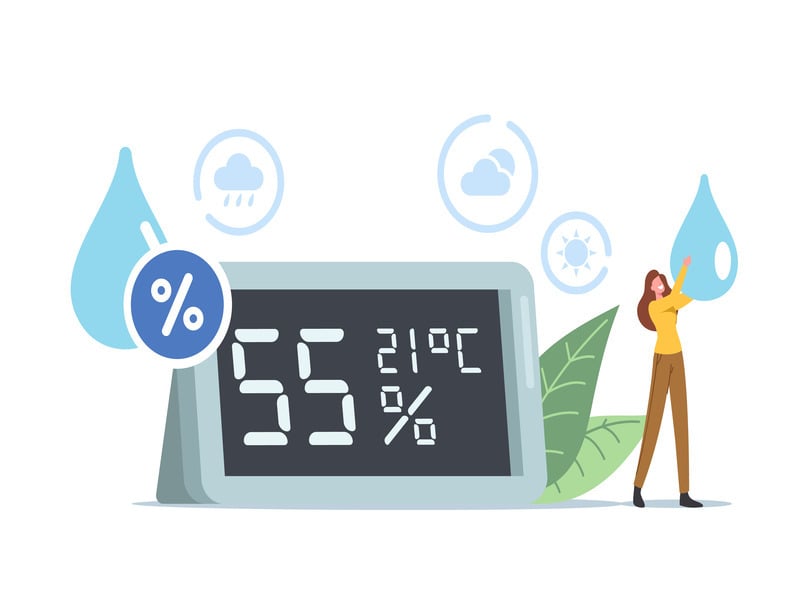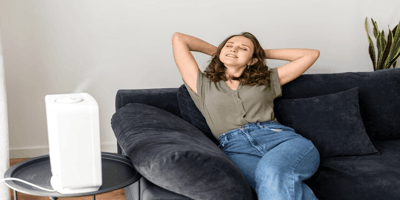How to Calculate And Reduce Your Home's Humidity Level
Key Takeaways
- Your family produces more moisture than you realize — research shows each person generates 1.8-3.7 pounds of water vapor daily just from breathing and perspiration, before adding cooking, showering, or laundry activities
- The 60% humidity threshold triggers rapid mold growth — EPA guidelines warn that materials must dry within 24-48 hours above this level, making 30-50% the safe operating range for preventing structural damage and health issues
- Indoor laundry drying dominates your moisture budget — each load releases 5 liters of water vapor into your home, more than an entire day of cooking and dishwashing combined, making this the highest-impact target for humidity control
- Exhaust fan timing matters more than fan size — running bathroom fans for 30 minutes after showers and kitchen fans for 15-20 minutes after cooking removes moisture that continues evaporating from surfaces long after you finish
- Room-specific solutions outperform generic approaches — basement condensation needs insulation fixes, kitchen moisture requires proper CFM calculations, and bedroom problems often resolve with simple airflow improvements rather than expensive equipment
- Weekly tracking beats daily obsessing for sustainable results — monitoring trends over 2-3 weeks reveals which changes actually reduce humidity in house environments, while daily readings create false urgency and mask normal fluctuations
- Source elimination trumps mechanical removal every time — preventing moisture at its origin through covered cooking, outdoor clothes drying, and proper ventilation costs less and works more reliably than trying to extract humidity after it spreads throughout your home
Your family produces more moisture than you realize. Research shows humans generate 0.8-1.7 kg (1.8-3.7 lbs) of water vapor daily per person through breathing and perspiration alone. Add cooking, showering, and laundry, and you're fighting a constant moisture battle. The EPA warns that wet materials must dry within 24-48 hours or mold takes hold.
Most homeowners fail because they treat symptoms, not causes. Opening windows during humid weather backfires. Undersized dehumidifiers create false security while moisture accumulates in hidden spaces. Running random fans wastes energy without strategic airflow.
The key to effective humidity control starts with measuring your actual moisture production, then targeting the biggest sources first. Every successful effort to reduce humidity in house environments requires understanding both where moisture comes from and how to remove it systematically.
This article covers how to calculate your daily moisture load, implement source-specific reduction strategies, size dehumidifiers correctly, and create room-by-room action plans that actually work.
Calculate Your Daily Moisture Load
Skip the guesswork and measure your actual moisture production. Most families underestimate their daily output by 300-400 percent, leading to undersized solutions and persistent problems. The calculation requires tracking your high-impact activities and multiplying by frequency.

Kitchen Operations
Your kitchen generates the most consistent moisture load. Cooking produces up to 3 liters of moisture per day, while dishwashing contributes 1 liter per load. For a family preparing three meals daily and running the dishwasher once, that's 4 liters before considering any other sources. Multiply this by your actual cooking frequency - families who meal prep or cook elaborate dinners can double these numbers.
Laundry and Bathroom Impact
Laundry creates the single largest controllable moisture spike in most homes. Each load of clothes dried indoors releases 5 liters of moisture - more than a full day of cooking and dishwashing combined. A family running three loads weekly adds 15 liters, or nearly 4 gallons, to their weekly moisture budget. Meanwhile, each shower or bath produces 1.5 liters of moisture. Four people taking daily showers contribute 6 liters daily, or 42 liters weekly.
Hidden Contributors and Your Total
Hidden sources accumulate rapidly without notice. Plants release about 0.5 liters of water per week for average-sized specimens. A household with 10 plants adds 5 liters weekly. Portable gas heaters, aquariums, and even housecleaning contribute measurable amounts.
Your calculation framework works like this:
|
Daily cooking (3L) + Daily dishwashing (1L) + Daily showers (1.5L × family size) + Weekly laundry (5L × loads ÷ 7) + Plants (0.5L × count ÷ 7) |
A typical family of four generates 12-18 liters of water vapor daily from activities alone.
Focus your efforts where the math shows the biggest impact. If your calculation reveals that indoor laundry drying produces 5 liters while cooking produces 3 liters, tackle laundry first. This targeted approach means you'll see meaningful humidity control improvements within days rather than weeks, and your efforts to reduce humidity in house spaces become measurably more effective.
Strategic Humidity Reduction by Source Control
Now that you know your moisture load, target each source with proven methods. The most effective strategies attack moisture at its origin rather than trying to remove it after it spreads throughout your home.
Source Elimination Tactics
Laundry Moisture Control
- Move clothes drying outdoors whenever possible
- Vent tumble dryers directly outside through shortest path
- For indoor drying: use least humid room with dedicated fan
- Keep laundry room doors closed to prevent moisture migration
Kitchen Moisture Control
- Keep lids on pots and pans during cooking
- Run exhaust fan during cooking + 15-20 minutes after
- Disable dishwasher heat-dry setting - crack door open instead
- Install exhaust fan rated for 100 CFM (kitchens under 300 sq ft)
 Bathroom Humidity Control
Bathroom Humidity Control
Your bathroom fan requirements: 50 CFM for rooms under 100 square feet, or 1 CFM per square foot for larger spaces. Run during showers and 30 minutes afterward. Cut shower duration by 2 minutes to reduce moisture production significantly.
Ventilation Science
Strategic air movement prevents moisture from accumulating in problem zones. Natural ventilation works best during temperature transitions - early morning and evening when outdoor air contains less moisture.
Best Practices:
- Create cross-ventilation: open windows on opposite sides when outdoor humidity stays below 60%
- Position fans to push humid air toward exits, not circulate randomly
- Run ceiling fans counterclockwise in summer to pull humid air upward
- Avoid opening windows during peak humidity (typically mid-afternoon)
Mechanical Extraction
When source control and ventilation can't maintain humidity below 50%, dehumidifiers provide the precision you need. They work by cooling air to condense moisture, then reheating it before returning drier air to your space.
Dehumidifier Sizing:
- 30-pint units: Handle up to 500 sq ft with moderate dampness
- 50-pint units: Cover up to 800 sq ft or severe moisture problems
Setup Tips:
- Place in central location with airflow around all sides
- Set target humidity levels at 40-50% (not continuous operation)
- Use separate digital humidity meter to verify built-in readings
- Empty tanks daily or connect drain hoses
 Layered Approach
Layered Approach
Combine methods systematically: start with source elimination in highest-moisture areas, add ventilation where natural airflow helps, then use mechanical dehumidification for the remaining problem spaces. This sequence helps you reduce humidity in house environments efficiently by addressing multiple sources in the right order.
Room-Specific Humidity Lowering Plans
Different rooms create distinct moisture challenges requiring tailored solutions. Your basement behaves differently than your bathroom, and cookie-cutter approaches rarely work well.
Basements
Most basement humidity problems have three possible culprits, and the solution depends entirely on which one you're dealing with.
If you see condensation on pipes or walls, this screams insulation problems. Cold surfaces meeting warm, humid air create instant condensation. Wrap those pipes in foam insulation and check your rim joists. Many basements lose the humidity battle because cold foundation walls keep creating new moisture from perfectly dry air.
Musty smell but no visible moisture? Your foundation is probably letting groundwater vapor seep through. Check that your gutters actually direct water away from the house - most people assume theirs work fine until they look during a heavy rain. Foundation moisture gets worse before it gets better, so don't wait.
Humidity spikes when your air conditioning runs? Your HVAC system might be creating the problem instead of solving it. Leaky ducts can pull humid outdoor air directly into your basement, or your system might not be treating basement air at all.
The target for basements is simple: stay under 50% humidity year-round. Summer humidity should hit 40-45% if possible.
Kitchen
Your exhaust fan needs to move enough air to actually remove steam and cooking moisture. Most kitchens have undersized fans that sound busy but accomplish little.
Here's the math: measure your kitchen length, width, and ceiling height. Multiply all three numbers together, then divide by four. That gives you the baseline air movement you need. Add 100 CFM if you cook with gas, 50 CFM for electric. So a 10×12 foot kitchen with 9-foot ceilings needs at least 270 CFM, plus another 100 for gas cooking.
Run the fan before you start cooking, not after steam already fills the room. Keep it going for 15-20 minutes after you finish. Most people shut off their fans too early and lose half the benefit.
 Bathrooms
Bathrooms
Bathroom fans need to move 50 CFM in small bathrooms (under 100 square feet) or 1 CFM per square foot in larger ones. Add 50 CFM for each toilet, shower, or tub if you have multiple fixtures.
The timing matters more than most people realize. Turn the fan on before you start your shower, run it during the shower, and let it keep going for 30 minutes afterward. Steam settles on surfaces and keeps evaporating long after you leave the bathroom.
If you still get condensation with proper fan size and timing, you probably need a second exhaust point or supplemental dehumidification.
Bedrooms
Most bedrooms stay comfortable through normal air conditioning, but check monthly to catch problems early. Look for morning condensation on windows, musty smells in closets, or humidity readings above 50%.
Simple fixes work well in bedrooms: crack the door during sleep for better air circulation, pull furniture away from exterior walls, or add a small fan in corners where air doesn't move well.
When you tackle each room based on its specific moisture sources, you'll reduce humidity in house spaces much more effectively than trying the same approach everywhere. Focus on your worst rooms first - success there makes maintaining humidity control in other areas much easier.
Humidity Measurement and Monitoring System
Measuring your progress prevents wasted effort and catches problems before they become expensive repairs. Without tracking, you're essentially flying blind - you might feel like conditions improved, but feelings don't prevent mold growth.
Equipment Setup and Placement
Digital hygrometers cost $10-20 and provide the accuracy you need for effective monitoring. Avoid the cheap analog versions that swing wildly with temperature changes. Look for models that display both current readings and 24-hour highs and lows.
Place hygrometers in your problem areas, not where conditions feel comfortable. Basements, bathrooms, and kitchens need more monitoring than living rooms. Position them away from heat sources, air vents, and exterior walls where readings might be misleading. About four feet off the floor gives you the most representative measurement of what people actually breathe.
Test your hygrometer accuracy with the salt test: put a small cup of regular table salt in a sealed container with your hygrometer for 24 hours. The reading should stabilize at 75% humidity. If it reads high or low, note the difference and mentally adjust your readings accordingly.
 Tracking That Actually Works
Tracking That Actually Works
Weekly readings work better than daily obsessing. Check your problem rooms every Sunday at the same time of day, preferably morning, before daily activities change conditions. Write down the numbers - memory fails, especially when you want to believe things are improving.
Track patterns, not just single readings. Humidity naturally fluctuates with weather, cooking, and seasonal changes. Look for trends over 2-3 weeks rather than panicking about one high day. Summer readings will run higher than winter readings in most climates.
Record major changes you make to your system. Note when you start running exhaust fans longer, install a dehumidifier, or change your laundry routine. This connects cause and effect, so you know which changes actually help reduce humidity in house environments and which ones waste your time.
Reading Your Results
Target ranges depend on the season and your local climate. Summer humidity between 40-50% indicates good control in most regions. Winter readings can safely run lower, around 30-40%, without causing comfort problems.
Signs your system needs adjustment:
- Readings consistently above 55% despite your interventions
- Large swings (more than 20% difference between daily high and low)
- Persistent condensation on windows during typical weather
- Musty odors developing in previously dry areas
Warning signs that require immediate action:
- Any room staying above 60% for more than two consecutive days
- Visible moisture or mold appearing anywhere
- Readings climbing instead of improving after implementing changes
Fine-Tuning Your Approach
When numbers don't improve as expected, work backwards through your moisture sources. Check that exhaust fans actually move air to the outside - blocked vents defeat even the best equipment. Verify that dehumidifiers drain properly and aren't cycling off due to full tanks.
Seasonal adjustments keep your system working efficiently. Summer often requires more aggressive dehumidification, while winter might need less ventilation to avoid over-drying. Your monitoring data shows these patterns clearly after a few months of consistent tracking.
Successful long-term humidity control happens when you:
- Check readings weekly, not daily
- Focus on trends over 2-3 weeks, not single readings
- Adjust your methods based on actual data, not assumptions
- Maintain equipment regularly to prevent performance degradation
Most people who successfully maintain healthy humidity levels spend about 10 minutes per week on monitoring and seasonal adjustments. The key is consistency - regular small adjustments prevent major problems that require expensive solutions later.
Managing home humidity requires targeting your biggest moisture sources first, not applying random solutions everywhere. Calculate your daily moisture load, address your highest contributors systematically, and monitor weekly to verify progress. This data-driven approach prevents both expensive mistakes and persistent problems that generic advice can't solve.
FAQ
What is the ideal humidity level in a house and why does it matter?
The safe humidity level indoors is 30–50%. Once it rises above 60%, mold begins to grow rapidly and structural damage can occur. That’s why consistent humidity control is essential for a healthy and safe home.
Why is it important to reduce humidity in house and how much moisture does a family create?
Each person releases 1.8–3.7 pounds of water vapor daily just through breathing and perspiration. Add cooking, showers, and laundry, and a family of four can generate 12–18 liters of moisture per day. If you don’t reduce humidity in house, it builds up quickly, leading to mold, musty odors, and potential health issues.
What is the biggest source of moisture and how can I decrease humidity in house quickly?
Indoor laundry drying is the top culprit — one load releases about 5 liters of water vapor. Targeting laundry first is the fastest way to decrease humidity in house, even more effective than focusing only on showers or cooking.
What’s the best way to track humidity and maintain long-term humidity control?
Use a digital hygrometer and check readings once a week at the same time. Ideal ranges: 40–50% in summer and 30–40% in winter. If your humidity level stays above 60% for more than two days, it’s time to take stronger humidity control measures like dehumidifiers or improved ventilation.



































.jpg?height=200&name=photo_2024-05-24_21-38-57%20(1).jpg)

.jpg?height=200&name=strategic-meeting-room-setting-staged-for-crucial-business-decisions%20(1).jpg)
